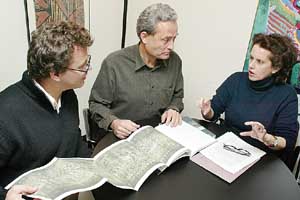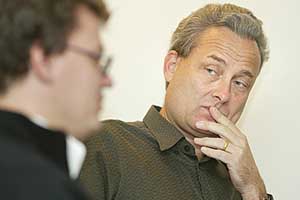Anthropologists will examine impact of environment on development of Angkor complex
By William HarmsNews Office
 The Tonle Sap Lake, which nourishes a vital agricultural system throughout Cambodia’s Angkor temple complex, will be the testing site for a new project being led by Alan Kolata, Chairman of Anthropology. In addition to testing the waters of the lake for its biological life throughout history, the group also will study human-environment interactions in the region.  Philippe Peycam (left to right), Alan Kolata and Anne Cunningham discuss the project they will undertake in Cambodia’s Angkor temple complex beginning in December. The team of scholars will take mud samples from the Tonle Sap Lake, which provides a vital agricultural system for the Cambodians.  Alan Kolata (right) meets with his colleague Philippe Peycam to discuss the project. |
University scholars, collaborating with colleagues in Cambodia, will initiate in December a project to examine the interactions between people and the environment in the northwestern part of the country, home of the Angkor temple complex, among the world’s largest archaeological sites and one of its richest agricultural regions.
Chairman of Anthropology Alan Kolata, who has studied agriculture and the environment in Thailand and South America, said current developments in the Cambodian region have made this project urgent.
“The agricultural system is under threat because the Chinese are building dams along the Mekong River that could seriously disrupt the water flow to the Tonle Sap, the largest freshwater lake in Southeast Asia and a major natural resource for the region. That’s why it’s important to do this work now to understand how the environment and the population have interacted over time,” said Kolata, who also is the Neukom Family Professor in Anthropology and the College.
Recent Anthropology Ph.D. graduate Anne Cunningham, a University researcher and a specialist on South Asia, will join Kolata, as will their partner in the project, the Center for Khmer Studies, a Cambodian-based institution.
The team plans to study the region located around the Angkor complex, where the Khmer empire flourished from the ninth to the 15th century A.D. Specifically, the team will study human-environment interactions around the Tonle Sap Lake.
Each year, the lake increases substantially in size because of seasonal floodwaters carried by the Mekong River. The enormous quantity of water in the Mekong causes a smaller river that normally drains the Tonle Sap to reverse course, flooding a vast region of northwest Cambodia.
In order to study the changing interactions between the populations and their environment, Kolata and his colleagues, including ecologists from the University of Florida, will analyze sediment cores extracted from the bottom of the Tonle Sap.
“We expect to be able to go back to at least 5,000 years ago in reconstructing the environmental history of the region,” Kolata said. The cores will reveal the aquatic life that has been present, what plants were common, and how climate change and human activities have affected the area over time. They also may reveal when the river that drains the lake began reversing course in a seasonal cycle.
In October, Kolata and Cunningham met with Philippe Peycam, director of the Center for Khmer Studies. Like the University, the Center for Khmer Studies is committed to its own research and to training Cambodian researchers to study the region after decades of civil strife.
The fundamental environmental research being planned will bring new insights for scholars studying the area, Peycam said. Other institutions are doing work on art history and monument restoration, but no other institution is looking systematically at the interaction between environment and culture.
“This will provide an inclusive look at the culture, including the elites who commissioned the massive temple complexes, as well as the other social groups in the culture,” he said.
Scholars have been studying the region since French colonization at the end of the 19th century. That work continues today, led by the École Française d’ Extrème Orient and other groups representing a wide range of countries.
The region grows a massive amount of rice, a commodity that once helped to secure the Khmer empire’s wealth. The Hindu and Buddhist cultures of India heavily influenced the empire, which also established a huge capital city that included Angkor Wat, the most famous temple of the complex.
Collecting information on the environment will help scholars understand the achievements of the culture in its own terms, Cunningham said. “So many of the rituals are connected with agriculture,” she said.
Indian civilizations greatly influenced the culture that developed in the Angkor plain, and traders most likely introduced those cultural characteristics.
“The Khmer people reinterpreted Hinduism in a style that reflects their own culture, but they also were true to many of the features of Indian civilization, including using a form of Sanskrit that was probably truer to the original form of the language than was the language being used in India at the time,” she said.
Once work is completed during the pilot phase in December, Kolata expects to seek support for further research in the region.
![[Chronicle]](/images/sidebar_header_oct06.gif)